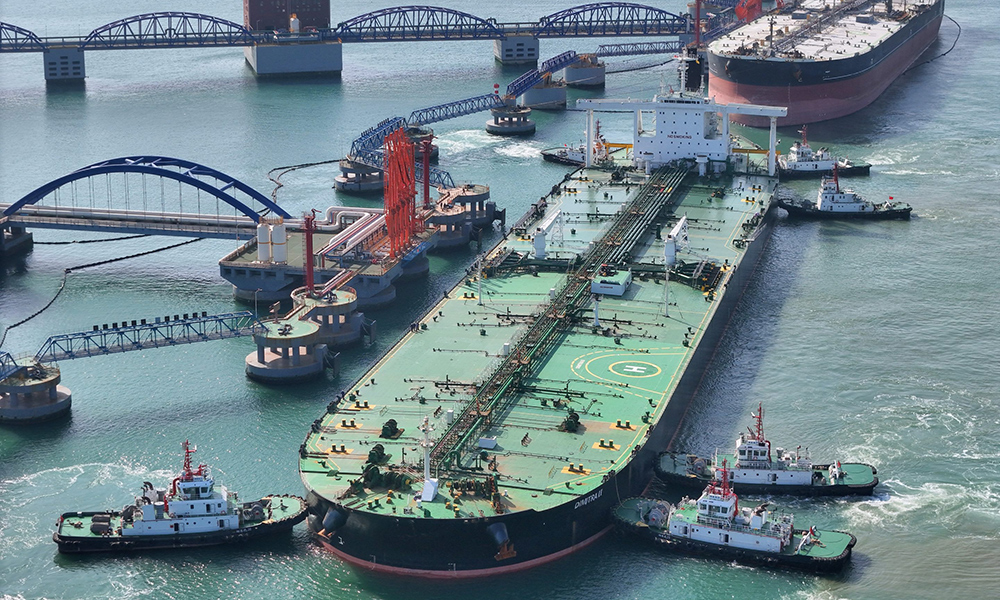
本季度,美国一些顶级炼油厂正在缩减其设施的运营,这加剧了人们对全球原油供应过剩的担忧。
美国最大炼油厂的所有者马拉松原油公司(Marathon Petroleum Corp.)计划本季度将其13家工厂的平均产能维持在90%左右,这是自2020年以来同期的最低水平。同样,PBF Energy Inc.宣布正准备加工三年来最少的原油量,Phillips 66将炼油厂的运营降低至接近两年来的最低水平,美国瓦莱罗能源公司(Valero Energy Corp.)预计将削减原油加工量。
这四家炼油厂的总产能约占美国汽油和柴油总产能的40%。
作为全球供需平衡的关键因素,美国燃料生产体系正因需求停滞和利润率缩减而陷入困境。尽管欧佩克+(OPEC+)减产,且地缘政治紧张局势不断加剧,但这种放缓态势增加了原油供应过剩即将来临的可能性,这一威胁仍将今年的油价涨幅限制在约7%左右。这一趋势也与国际能源署(International Energy Agency)的预测相悖,该机构预计全球炼油商今年将每天多加工近90万桶原油。
麦格理(Macquarie)全球油气策略师维卡斯·德维韦迪(Vikas Dwivedi)在休斯顿接受采访时说:“炼油利润受到压缩,这为美国炼油厂在秋季进行新一轮大规模维修创造了条件。这将对供需平衡带来压力,并可能增加美国今年余下时间的原油库存。”
在中国这个全球最大的石油进口国,电动汽车和以液化天然气为燃料的重型卡车日益普及,与此同时炼油厂关闭、改造和新增产能的时间错配,导致将原油转化为燃料的利润率不断缩减。
与此同时,即便有新的炼油厂在提升产量,预计全球原油供应到今年年底仍会增加。美国已将部分过剩的原油运往尼日利亚的丹格特(Dangote)大型炼油厂(该炼油厂一直在大肆开采二叠纪地层的石油),而墨西哥的多斯博卡斯炼油厂(Dos Bocas refinery)也将于今年投产。据彭博新能源财经(Bloomberg NEF)的数据,从2023年到2030年,预计全球每天将新增约490万桶的净产能,与印度目前的产量相当。
但这种缓解可能只是短暂的,因为圭亚那正在提高产量,而石油输出国组织(OPEC)及其盟友计划在第四季度将日产量恢复至约54万桶。
虽然该计划可能会有所变动,但这些新增产量预计会在页岩油生产商从今年早些时候钻探的油井中开采石油时进入市场。德维韦迪表示,美国预计今年年底的日产量将达到创纪录的1380万桶,比去年同期增加约60万桶。
他表示,供应过剩的可能性正在降低地缘政治风险为原油价格带来的溢价。
“市场不再愿意为此支付高额溢价,因为到目前为止,这种紧张局势尚未导致原油产量减少。”德维韦迪说道,他预计第四季度布伦特原油基准价平均为每桶75美元,第二季度将跌至64美元。
按市值计算,美国最大的燃料制造商Phillips 66认为,利润率下降是其下调产量预测的原因。该公司首席财务官凯文·米切尔(Kevin Mitchell)在公司第二季度财报电话会议上表示,由于炼油利润"比我们近期看到的要低",这家总部位于休斯顿的公司计划进行预防性维护。
马拉松原油公司首席商务官里克·赫斯林(Rick Hessling)表示,该公司将在本季度以90%的“经济产能”运行,这是该时期多年来的低点。该公司还表示,中国经济仍然令人担忧,欧佩克的原油产量回归可能会在短期内引发一些波动。(财富中文网)
译者:中慧言-王芳
本季度,美国一些顶级炼油厂正在缩减其设施的运营,这加剧了人们对全球原油供应过剩的担忧。
美国最大炼油厂的所有者马拉松原油公司(Marathon Petroleum Corp.)计划本季度将其13家工厂的平均产能维持在90%左右,这是自2020年以来同期的最低水平。同样,PBF Energy Inc.宣布正准备加工三年来最少的原油量,Phillips 66将炼油厂的运营降低至接近两年来的最低水平,美国瓦莱罗能源公司(Valero Energy Corp.)预计将削减原油加工量。
这四家炼油厂的总产能约占美国汽油和柴油总产能的40%。
作为全球供需平衡的关键因素,美国燃料生产体系正因需求停滞和利润率缩减而陷入困境。尽管欧佩克+(OPEC+)减产,且地缘政治紧张局势不断加剧,但这种放缓态势增加了原油供应过剩即将来临的可能性,这一威胁仍将今年的油价涨幅限制在约7%左右。这一趋势也与国际能源组署(International Energy Agency)的预测相悖,该机构预计全球炼油商今年将每天多加工近90万桶原油。
麦格理(Macquarie)全球油气策略师维卡斯·德维韦迪(Vikas Dwivedi)在休斯顿接受采访时说:“炼油利润受到压缩,这为美国炼油厂在秋季进行新一轮大规模维修创造了条件。这将对供需平衡带来压力,并可能增加美国今年余下时间的原油库存。”
在中国这个全球最大的石油进口国,电动汽车和以液化天然气为燃料的重型卡车日益普及,与此同时炼油厂关闭、改造和新增产能的时间错配,导致将原油转化为燃料的利润率不断缩减。
与此同时,即便有新的炼油厂在提升产量,预计全球原油供应到今年年底仍会增加。美国已将部分过剩的原油运往尼日利亚的丹格特(Dangote)大型炼油厂(该炼油厂一直在大肆开采二叠纪地层的石油),而墨西哥的多斯博卡斯炼油厂(Dos Bocas refinery)也将于今年投产。据彭博新能源财经(Bloomberg NEF)的数据,从2023年到2030年,预计全球每天将新增约490万桶的净产能,与印度目前的产量相当。
但这种缓解可能只是短暂的,因为圭亚那正在提高产量,而石油输出国组织(OPEC)及其盟友计划在第四季度将日产量恢复至约54万桶。
虽然该计划可能会有所变动,但这些新增产量预计会在页岩油生产商从今年早些时候钻探的油井中开采石油时进入市场。德维韦迪表示,美国预计今年年底的日产量将达到创纪录的1380万桶,比去年同期增加约60万桶。
他表示,供应过剩的可能性正在降低地缘政治风险为原油价格带来的溢价。
“市场不再愿意为此支付高额溢价,因为到目前为止,这种紧张局势尚未导致原油产量减少。”德维韦迪说道,他预计第四季度布伦特原油基准价平均为每桶75美元,第二季度将跌至64美元。
按市值计算,美国最大的燃料制造商Phillips 66认为,利润率下降是其下调产量预测的原因。该公司首席财务官凯文·米切尔(Kevin Mitchell)在公司第二季度财报电话会议上表示,由于炼油利润"比我们近期看到的要低",这家总部位于休斯顿的公司计划进行预防性维护。
马拉松原油公司首席商务官里克·赫斯林(Rick Hessling)表示,该公司将在本季度以90%的“经济产能”运行,这是该时期多年来的低点。该公司还表示,中国经济仍然令人担忧,欧佩克的原油产量回归可能会在短期内引发一些波动。(财富中文网)
译者:中慧言-王芳
Some of the top US oil refiners are throttling back operations at their facilities this quarter, adding to concerns that a global glut of crude is forming.
Marathon Petroleum Corp. — owner of the largest US refinery — plans to operate its 13 plants at an average of 90% of capacity this quarter, the lowest for the period since 2020. Similarly, PBF Energy Inc. announced it’s preparing to process the least crude in three years, Phillips 66 will run its refineries near a two-year low and Valero Energy Corp. expects to trim oil processing.
Together, those four refiners account for about 40% of America’s capacity to churn out gasoline and diesel.
The US fuelmaking complex — a key factor in global supply-demand balances — is faltering as consumption stalls and profit margins shrink. The slowdown bolsters the possibility that an oversupply of crude is looming, a threat that has limited oil prices to a roughly 7% gain this year despite OPEC+’s production cuts and rising geopolitical tensions. The trend also bucks the International Energy Agency’s estimate that global fuelmakers will process almost 900,000 barrels a day more this year.
“Compressed refining margins are setting up the stage for another round of heavy refinery maintenance in the US during the fall season,” Vikas Dwivedi, Macquarie’s global oil and gas strategist, said in an interview in Houston. “That’s going to weigh on balances and may add to crude builds in the US for the rest of the year.”
Margins to convert crude into fuels are shrinking amid mismatches in the timing of refinery closures, conversions and new capacity additions at the same time as electric vehicles and heavy trucks fueled by LNG are growing in popularity in China, the world’s top oil importer.
At the same time, global supplies of crude are expected to rise through the end of the year, even as new refineries ramp up. The US has been able to ship some its surplus to Nigeria’s Dangote mega refinery — which has been feasting on oil from the Permian formation — and Mexico’s Dos Bocas refinery is slated to start production this year. In total, between 2023 and 2030, the world is expected to add about 4.9 million barrels a day of net capacity, roughly what India processes now, according to Bloomberg NEF.
But that relief may be short-lived as Guyana ramps up production while the Organization of the Petroleum Exporting Countries and its allies plan to bring back about 540,000 barrels of daily output in the fourth quarter.
While the plan is subject to change, those barrels are slated to hit the market as shale producers bring on output from wells that were drilled earlier in the year. The US is expected to finish the year pumping a record 13.8 million barrels a day, about 600,000 barrels more than the same period last year, Dwivedi said.
The potential for supplies to outstrip demand is reducing the premium geopolitical risks have added to crude prices, he said.
“The market is no longer willing to pay a huge premium for that because the tensions haven’t so far resulted in a loss of barrels,” said Dwivedi, who sees benchmark Brent oil averaging $75 a barrel in the fourth quarter and dipping to $64 in the second quarter.
Phillips 66, the biggest US fuelmaker by market value, cited those softer margins as the rationale for its reduced output projections. The Houston-based company plans to carry out preventive maintenance as refining margins are “weaker that we’ve seen in a little while,” Chief Financial Officer Kevin Mitchell said during the company’s second-quarter earnings call.
Marathon “will run economically in 90%” capacity this quarter, which is a multi-year low for the period, Chief Commercial Officer Rick Hessling said. The company also said the Chinese economy remains a concern and the return of OPEC barrels could inject some volatility in the short term.






